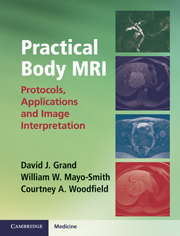Book contents
Chapter 15 - Chest MRA
from Section 4 - MRI angiography
Published online by Cambridge University Press: 05 November 2012
Summary
Chest MRA protocol
Indications
This protocol is most commonly used for assessment of aortic size as well as for evaluation and follow-up of aortic dissection. It may also be used to evaluate for stenosis of the great vessels. If the thoracic aorta is not the primary vessel of interest, consider changing the plane of acquisition of the pre- and post-contrast SPGRs (although they are 3D, so they can be reformatted later in any plane).
Preparation
IV contrast agent: gadobenate dimeglumine 0.1 mmol/kg at 2 cc/s
Oral contrast agent: None
2 L nasal oxygen
At least 22-gauge IV; connect to power injector
Scan with patient's arms overhead, if patient can tolerate, for smallest field of view possible
All sequences are cardiac-gated except the SPGRs.
Exam sequences and what we are looking for
(1) Axial double-inversion recovery SSFSE BH (dark blood) – Carefully evaluate the vessel wall and look for dissection flaps.
(2) Axial SSFP BH (bright blood; non cine) – Confirm vessel size and presence/absence of dissection flap.
(3) Coronal double-inversion recovery SSFSE BH – Examine aortic root, typically better seen in coronal plane.
(4) Sagittal oblique 3D-SPGR pre-contrast BH.
(5) Sagittal oblique 3D-SPGR post-contrast BH arterial – Best evaluation of great vessel anatomy and presence/absence of stenosis.
(6) Sagittal oblique 3D-SPGR post-contrast BH venous.
(7) Parasagittal cine SFFP 2D (candy-cane) – View the thoracic aorta in its natural plane. Lumen and wall can be evaluated. And as below dissection flaps may be identified.
(8) Axial SSFP cine (optional) if aortic dissection is known, suspected, or discovered. This essentially gives us 20–25 images at the same axial location. A flap can be detected, confirmed, and observed through the cardiac cycle.
- Type
- Chapter
- Information
- Practical Body MRIProtocols, Applications and Image Interpretation, pp. 143Publisher: Cambridge University PressPrint publication year: 2012



